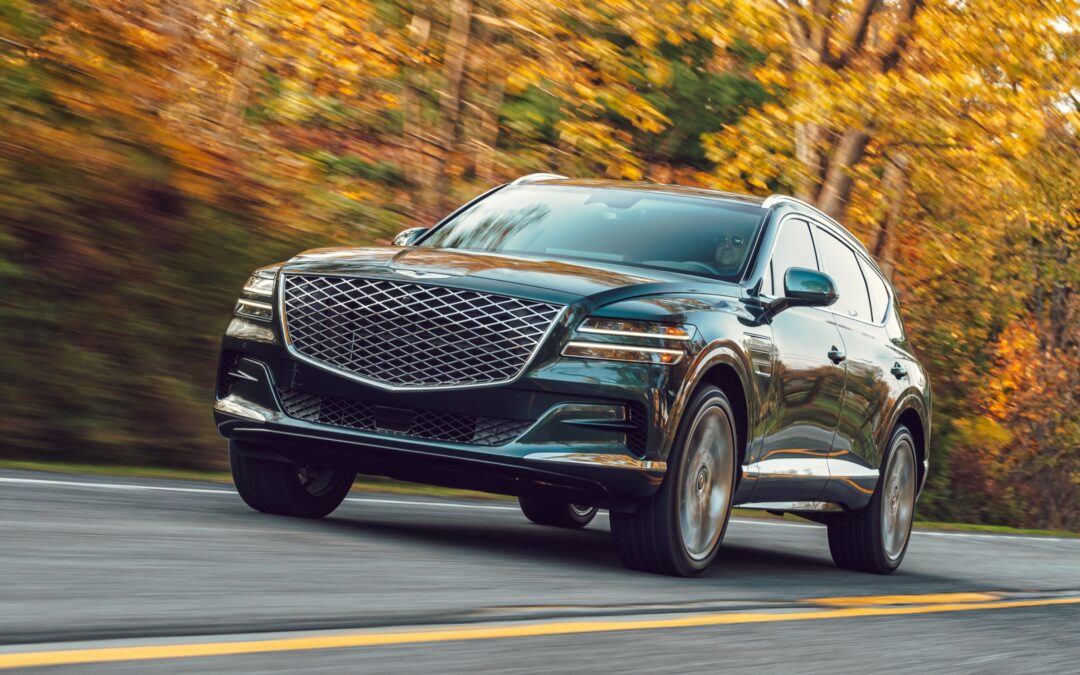The Genesis GV80 is a 5- or 7-seat carlike SUV that is a defining statement of luxurious refinement

The GV80 is sold in rear- or all-wheel drive versions with a choice of two turbocharged engines. (Genesis)
Not every SUV-intender wants to climb every mountain, spool-up rooster tails in a desert pre-run or clip apexes on a road course in high-speed pursuit to define themselves or at least who they like to think they are.
Some SUV shoppers just want the spaciousness and comfort they once had in a large family sedan, which has joined the dinosaurs in an evolving world.
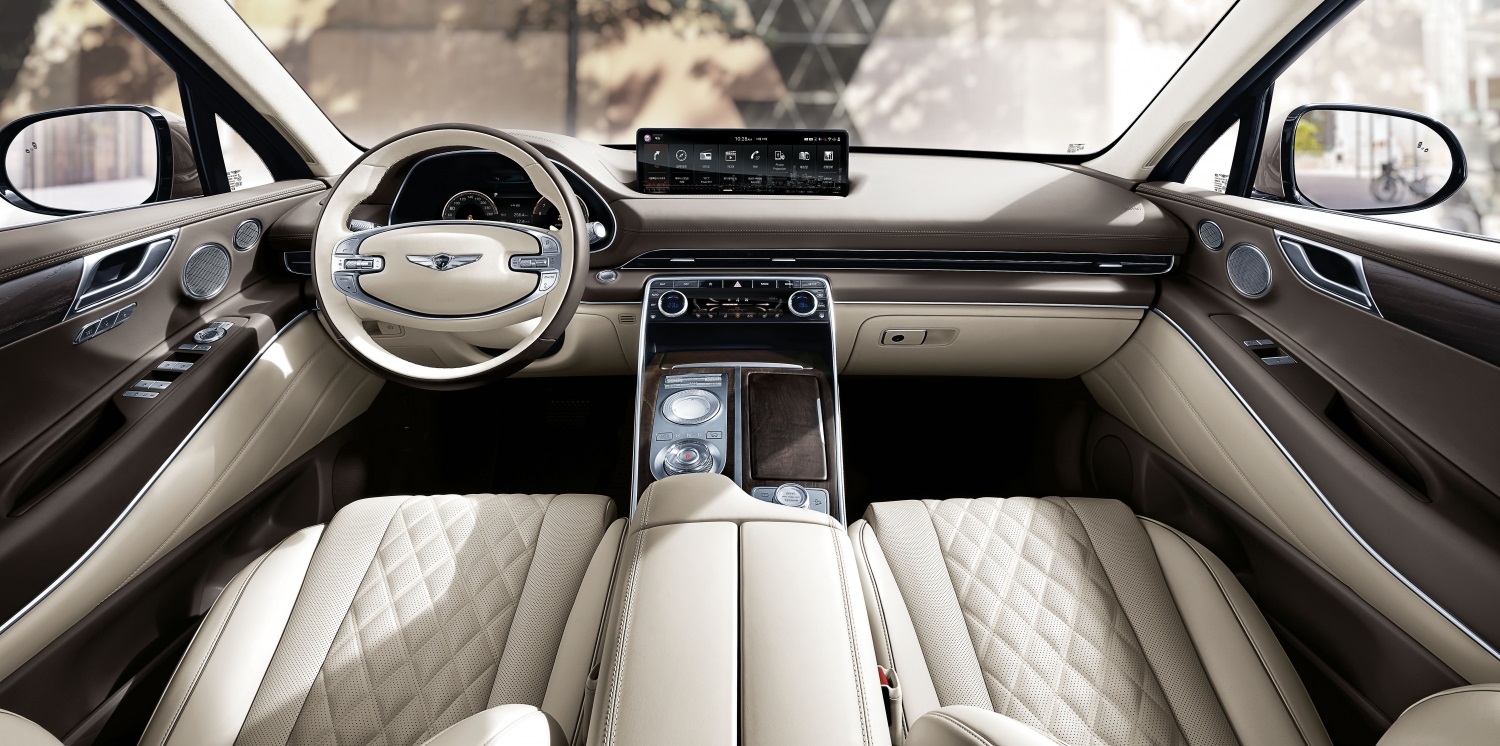
The front seat space has wide shoulder room and tall front headroom of almost 40 inches. (Genesis)
For them, there is the vital newcomer by a largely unrecognized brand, the Genesis GV80. The brand, a luxury spinoff from South Korean parent company Hyundai, actually launched in the U.S. in late 2016. But its debut vehicles were the G80 and G90 midsize and large sedans, which were largely overlooked by a lack of advertising, balky customer service and this country’s obsession with tall and large vehicles.
Those who did buy into the brand became fast believers. The cars were very well turned out with refined luxury and strong performance credentials. But always in the business plan was a lineup of SUVS: large, midsize, compact, “coupes” and electrified versions.

The 12.3-inch 3D instrument cluster recognizes the driver’s eyes. (Genesis)
Covid Delays
Due to COVID-19 related delays in the U.S, the logjam broke late last year with the debut of the redesigned large G80 sedan and the GV80 SUV, today’s tester.
This five- or seven-seat carlike SUV is a defining statement of elite luxury — at pricing that will send the luxury competitors back to their calculators.
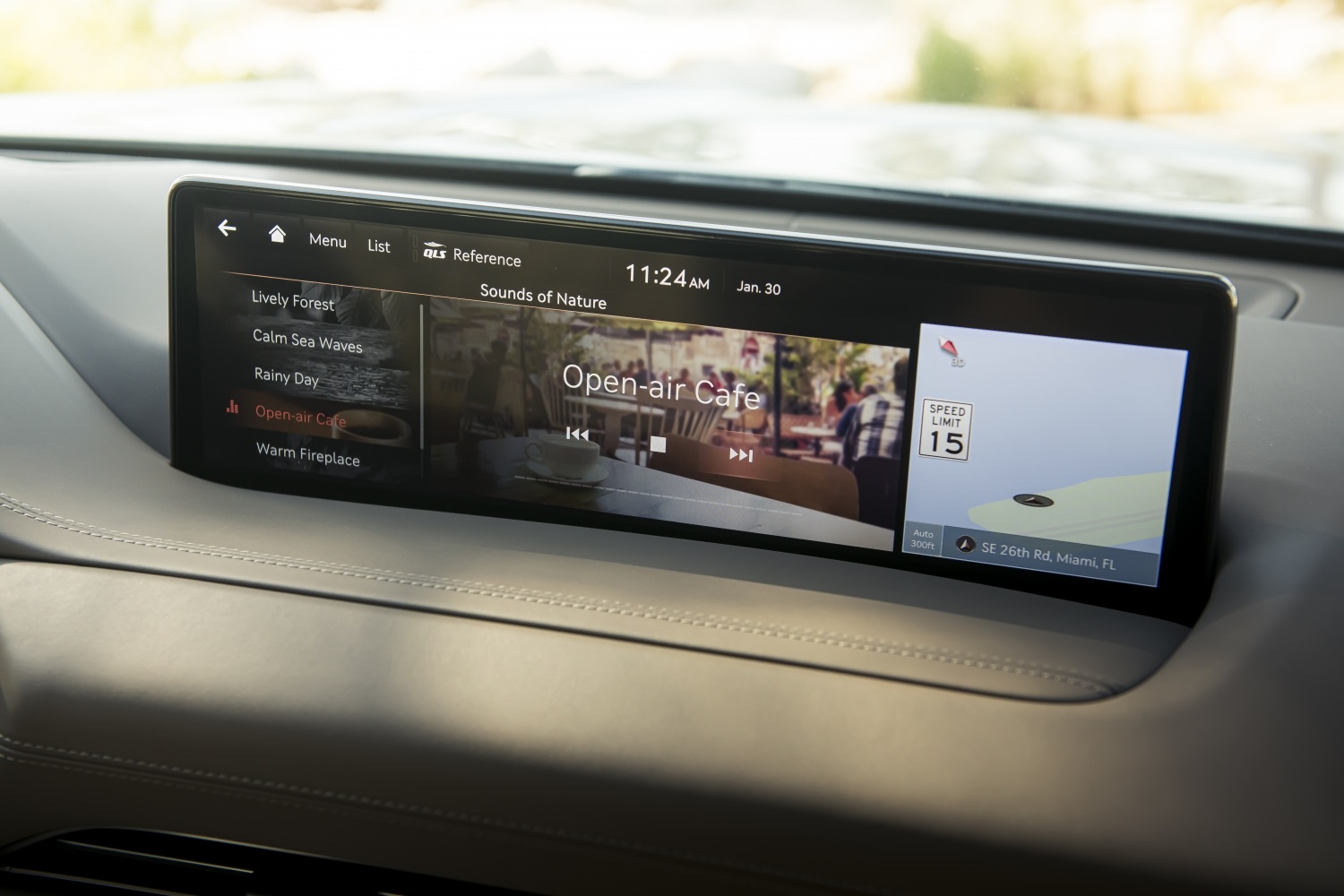
The 14.5-inch, split-screen infotainment display does not interfere with the driver’s sightline. (Genesis)
GV80 Pricing
The Genesis GV80 is sold in rear- or all-wheel-drive versions with either a 300-horsepower, 2.5-liter turbocharged four-cylinder engine or 375-hp, twin-turbocharged 3.5-liter V-6, with standard AWD.
Both engines are paired with an eight-speed automatic transmission with paddle shifters and selectable driving modes of Comfort, Smart, Eco, Sport and Custom.
The GV80 2.5T (RWD or AWD) is offered in three trim levels with starting prices that range from $49,925 to $64,425.
The 3.5T is sold in four trim levels with starting prices of $60,175 to $71,975. All MSRPs include the $1,025 freight charge from Ulsan, Korea.
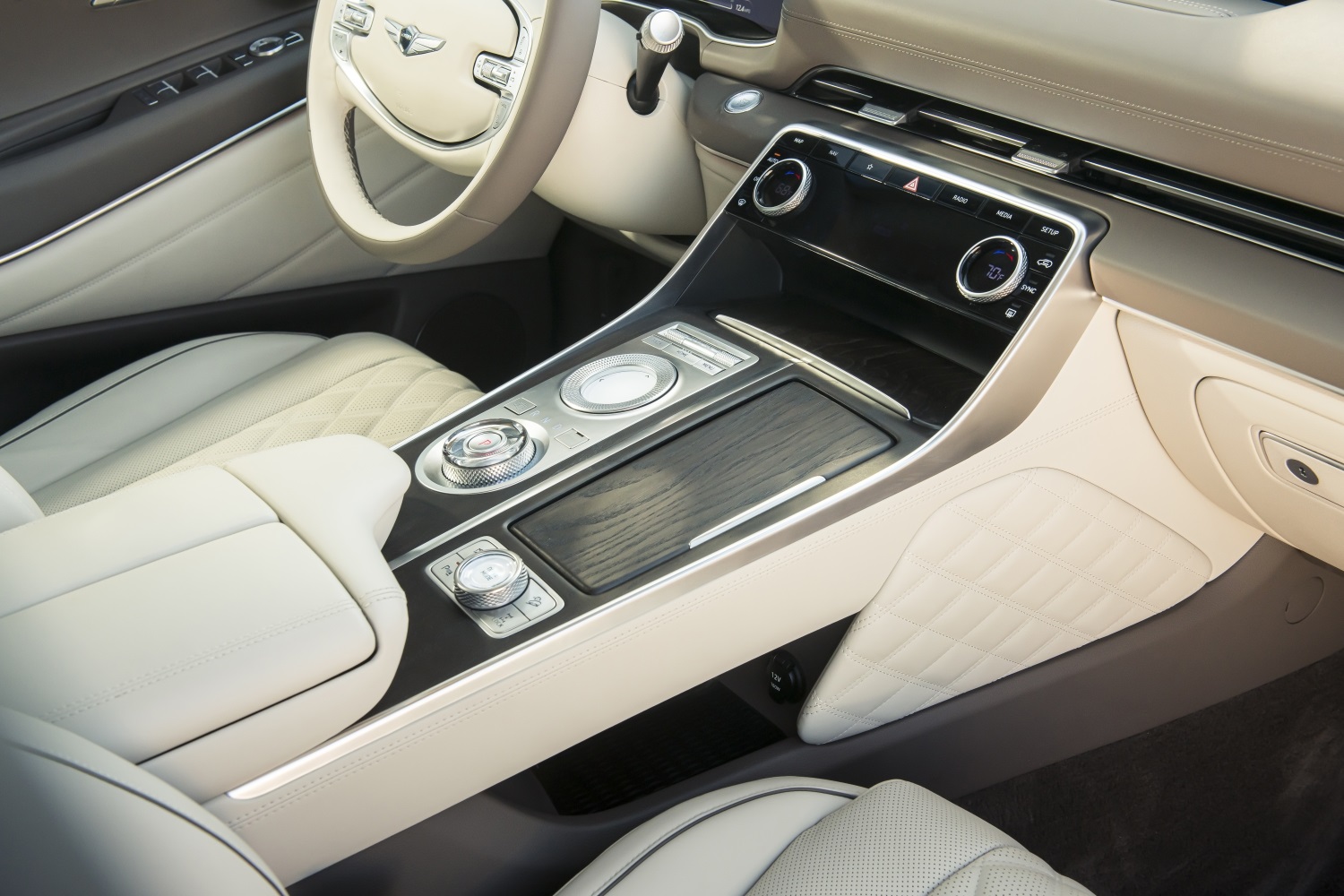
The center shift console has fresh function by using a low shifter dial and a large and flat dial for infotainment and other selections. (Genesis)
The top-line 3.5T Prestige tester was $72,375 with the two factory option packages (Advance and Prestige) and $400 for the gorgeous Adriatic Blue metallic paint.
Full package contents are listed in the specifications box at the end of the story.

The electronic climate system features capacitive touch controls with tactile feedback. (Genesis)
Genesis Warranties
- 10-years/100,000-miles powertrain with enhanced roadside assistance and concierge services;
- 3-years/36,000-miles of scheduled maintenance;
- 3-years/36,000-miles of complimentary Genesis Service Valet care;
- 3 years of free Genesis connected services;
- 3 months of free SiriusXM satellite radio all access
- 3 years of free annual multimedia and navigation updates and lifetime complimentary traffic data via HD+ Traffic radio.
And here’s the perk for which I’d pay extra: the free Genesis Service Valet for 3 years or 36,000 miles will perform a remote diagnostic check, pick up your vehicle, send a courtesy car and return your Genesis – cleaned and washed.
Find current Genesis GV80 pricing here.

In up-level models, soft materials cover every surface, from the inside of the door handles to the quilted knee pads along the console. (Genesis)
GV80 Safety Features
Among the 10 air bags is an active safety-first innovation, Genesis says. The front center air bag, located between the driver’s seat and center console, deploys in 0.3 seconds in the event of a side collision to help prevent the two front passengers from colliding with each other or with vehicle components. The feature is standard on all GV80 models.
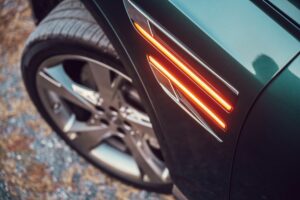
Power lines above each wheel emphasize stance and presence. (Genesis)
Defining Features
The GV80 is not an original idea, but it is a fresh presentation of what was and what it could be for much wider range of motorists.
There is an eye for beauty in the exterior styling. The compelling design is lean, fit and balanced. The chassis lowers the body and the center of gravity for a wider cabin and secure drivability. Its 16.2-foot-long architecture sits confidently on its wheels, which neatly fill the arches. There are no replicated kinks, gimmicky bulges or Godfather jowls. Yet it is well adorned with chrome, an American staple.
Roof cross-members, transmission tunnel, front chassis extensions and parts of the rear structure are made of ultra-high-strength steel. The cowl, floor panels, rear wheel housings and other components are high-strength steel. For light-weighting, aluminum is used for the doors, hood and rear decklid, for a 90-pound savings. The top-line, all-wheel-drive tester weighs in at 5,084 pounds.
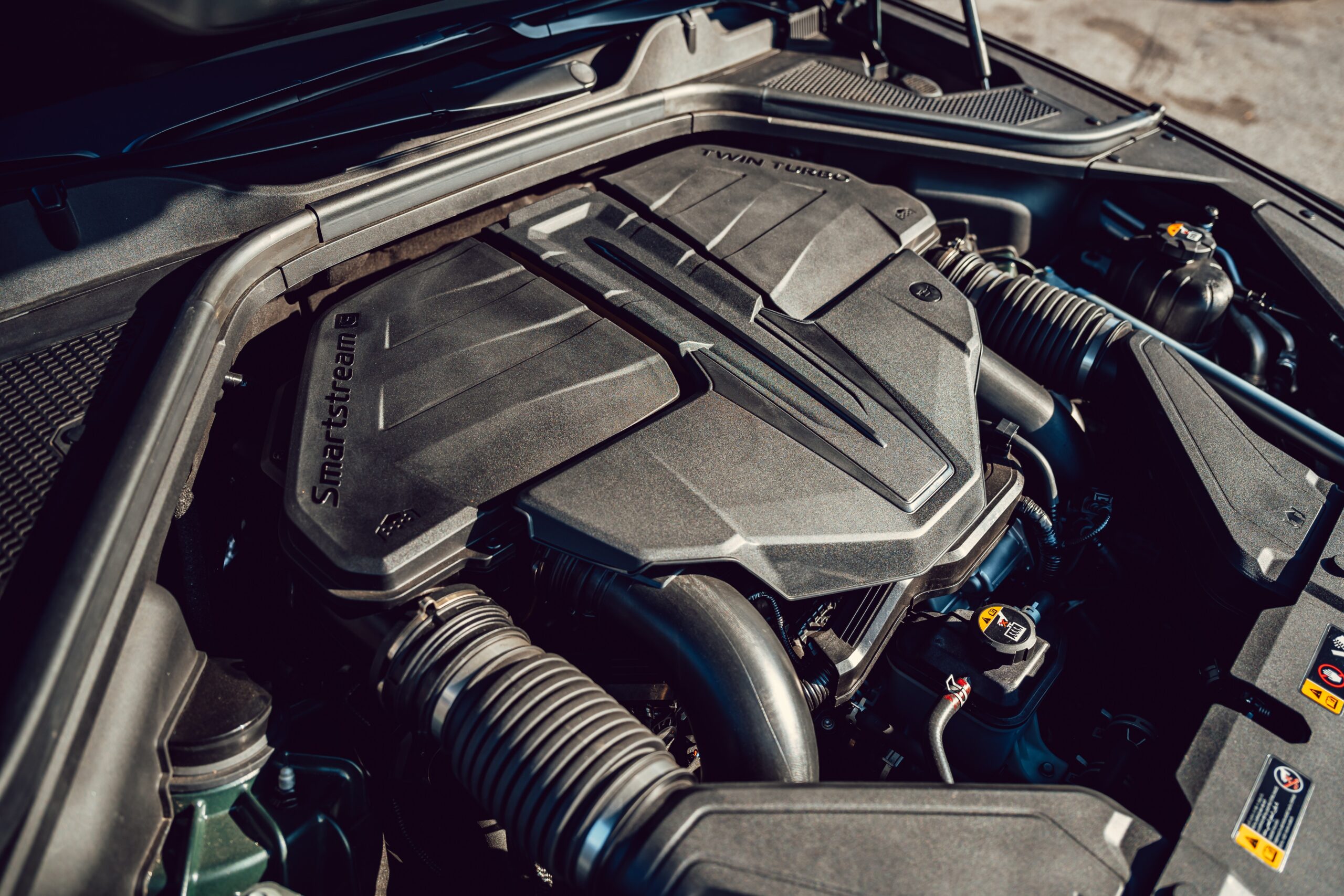
The 375-hp, twin-turbocharged 3.5-liter V-6 is paired with an eight-speed automatic transmission. (Genesis)
Genesis Attention to Detail
“The precise proportions and attention to every detail denote that GV80 is authentic to Genesis design principles,” said Hyundai Motor design chief Luc Donckerwolke.
Under the shapely exterior is a brain trust of advanced safety and driver-assist technologies. The so-called “machine learning” technologies merge, refreshingly for the user, without a fearsome curve of learning.
By activating the Smart Cruise Control and Highway Driving Assist (and its bank of camera and sensor arrays) the GV80 will steer, brake, corner, evade, warn the driver and find its way home.
And it can park itself, as you stand outside the vehicle, in spaces too narrow to open the door on exit.
While many of the highway steering-assist systems are still somewhat rudimentary in how they watch the road and make somewhat jerky connect-the-dots steering course. The GV80 has more refined and more-fluid steering calibrations. And while some systems will let the vehicle drift wide in sweeping corners — crossing the Botts dots or white lines — the GV80 held true to the arc, in my testing. And the guidance gave no random shut-offs, such as in bright sunlight or on California’s light gray concrete interstates, which confuse many of these systems.
Still, it is still a hands-on system, so don’t think you are in the rocking-chair position and can sit back and read e-mail.
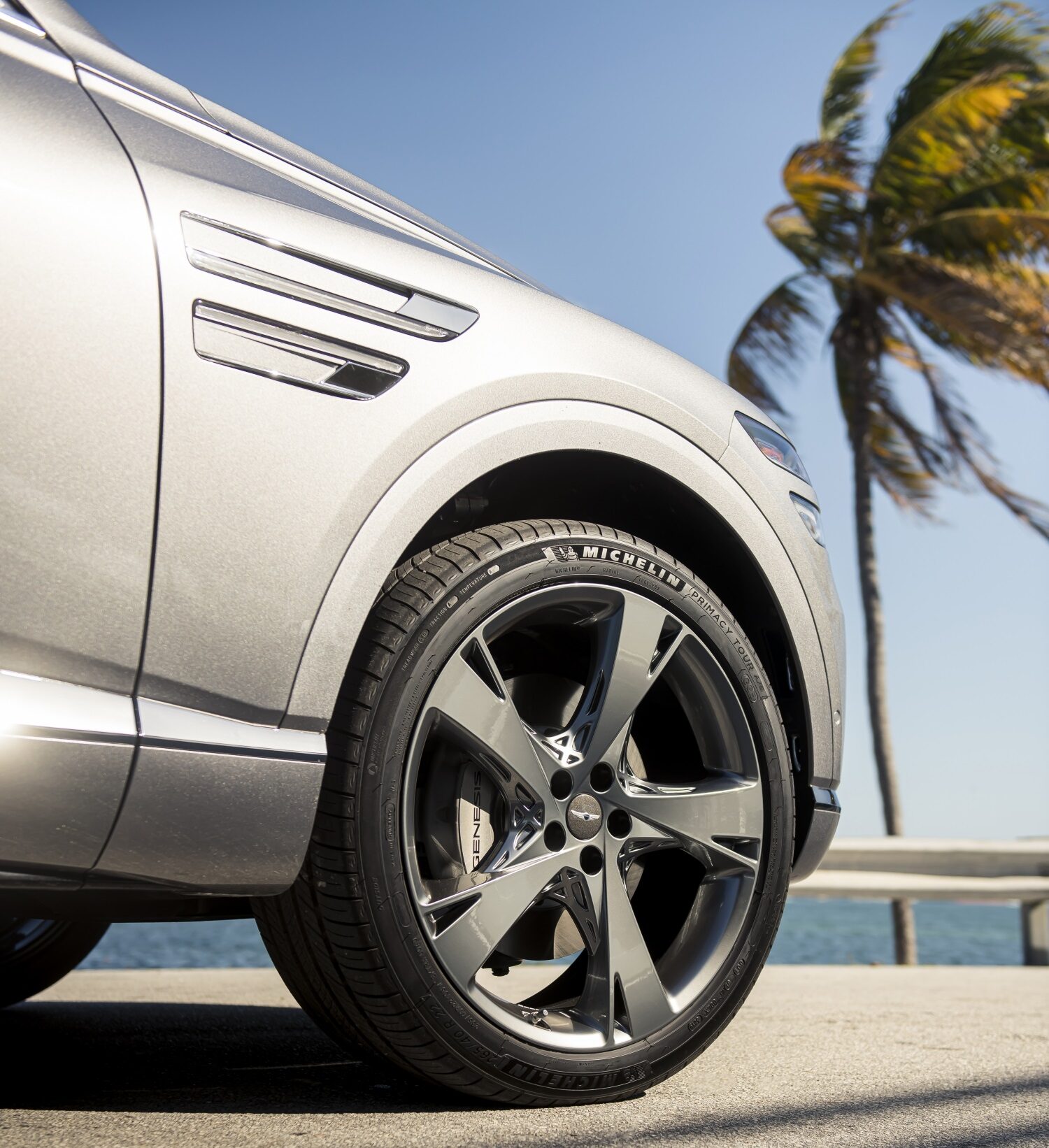
The Prestige package ($6,600) includes 22-inch alloy wheels with Michelin Primacy all-season tires. (Genesis)
GV80 Interior Function
When a new house is built by a team that works as a united front, the plans are thorough to provide the function, details and strength to sell quickly in its segment. The GV80 is that house. It has the needed electrical outlets, storage areas, ergonomic comfort and fortitude for long-term ownership.
For me, it was love at first … user experience, in the 3.5T Prestige, which is the king of that castle. Think Audi interior, but with even more finesse, or Volvo XC90, but even more ergonomic.
The GV80’s full Nappa leather upgrade, quilted and meticulously stitched, is impressive and inviting to the touch. The microsuede upgrade is used extensively from the headliner to the roof pillars and beyond.
It is a completely soft-touch environment, with progressive treatments for wood-like graining and metallic trim elements. And the cabin is well soundproofed for the 21-speaker Lexicon audio system.
Driver sightlines are open over the shoulder and at the front corners (handily provided by small corner glass at the base of the windshield pillars and side mirrors, which stand out from the body.
With front headroom at almost 40 inches (with the panoramic sunroof) and a long 41.6 inches of legroom, there is a 16-way power driver’s seat with adjustable side bolsters and cushion extension and four-way power lumbar, massaging driver’s seat. The passenger has a 12-way power seat with four-way power lumbar. Both front seats are heated and ventilated. And the Advance package adds the Ergo Motion (massaging) driver seat.
Roomy Interior
The large-midsize cabin has plenty of real estate for prime placement of controls and storage areas, including purse-size capacity under the shift console. The broad center shift console has fresh function by using a low shifter dial and a large and flat dial for infotainment, audio and navi selections, without eyes leaving the road. There’s also a handwriting sensor pad in the dial, for those competent in writing and driving (not me). A generous e-bin, with a sliding cover, includes a wireless charging pad and a pair of charging USBs.
I liked the 3D electronic presentation of the 12.3-inch digital gauge cluster and it is of ideal width for the dual blind-spot view monitors, which trigger a rearview image for right or left turns, filling either the speedometer or tach dials.
The 14.5-inch touch screen atop the center dashboard has a low profile that is not subject to sunlight glare and it does not get in the way of the driver’s view. But it also has good width for the surround-view monitor, which includes front and overhead views. I am not precise when fitting between the parking lines, so the overhead takes away the guesswork.
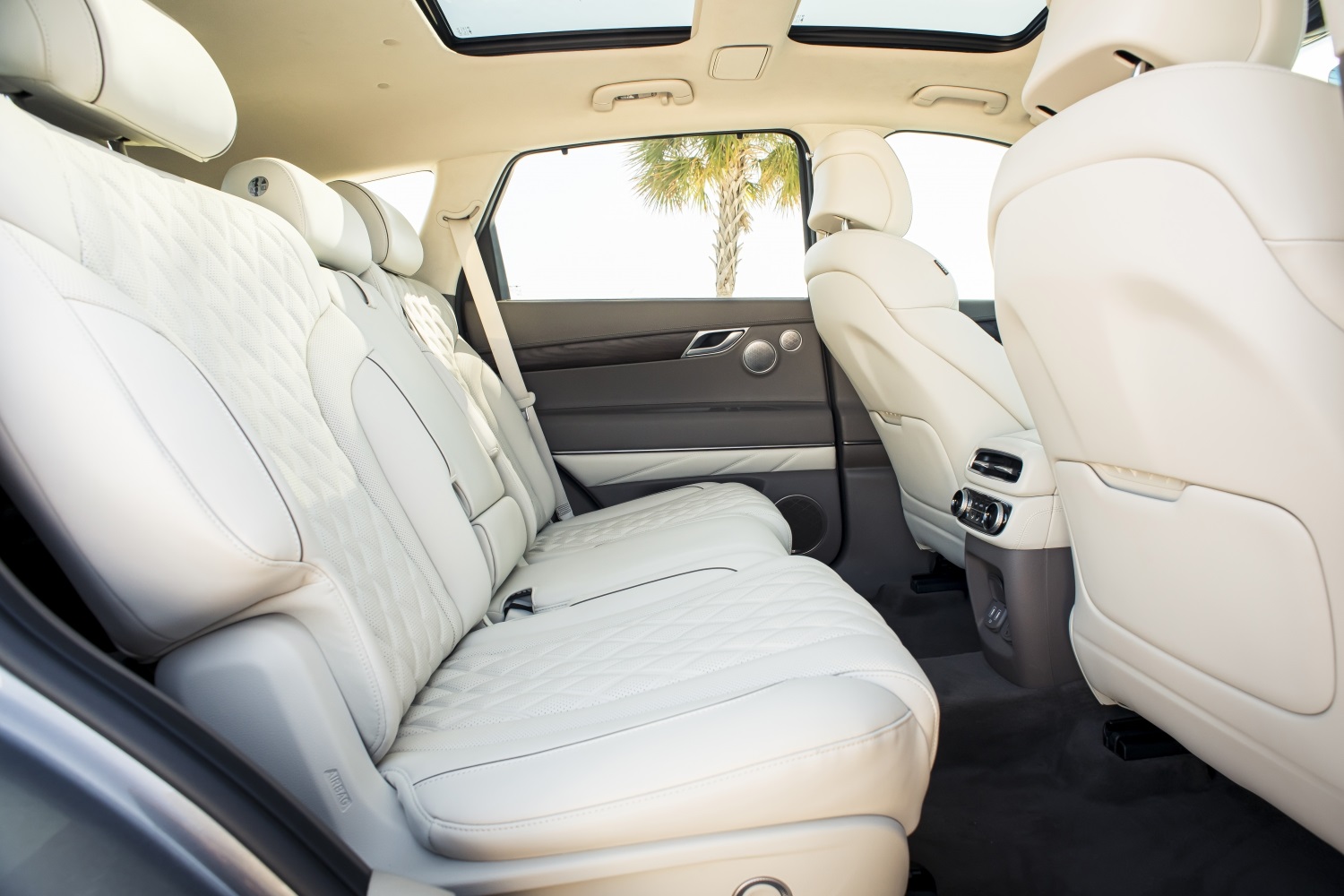
The second row has full temperature control, heated-ventilated window seats, and power recline. (Genesis)
GV80 Back Seat
Seating in the second row might be slightly more compact than some of the competition. But it is a gorgeous space (in the Prestige tester). Some of the features include ceiling-integrated flip-down vanity mirrors, full temperature control, heated and ventilated window seats, and power seat recline. There’s also a chauffeur-style power fore-aft adjuster for more legroom when needed.
The third-row option will be limited to the grandkids, with knee-crunching legroom of 30.3 inches.
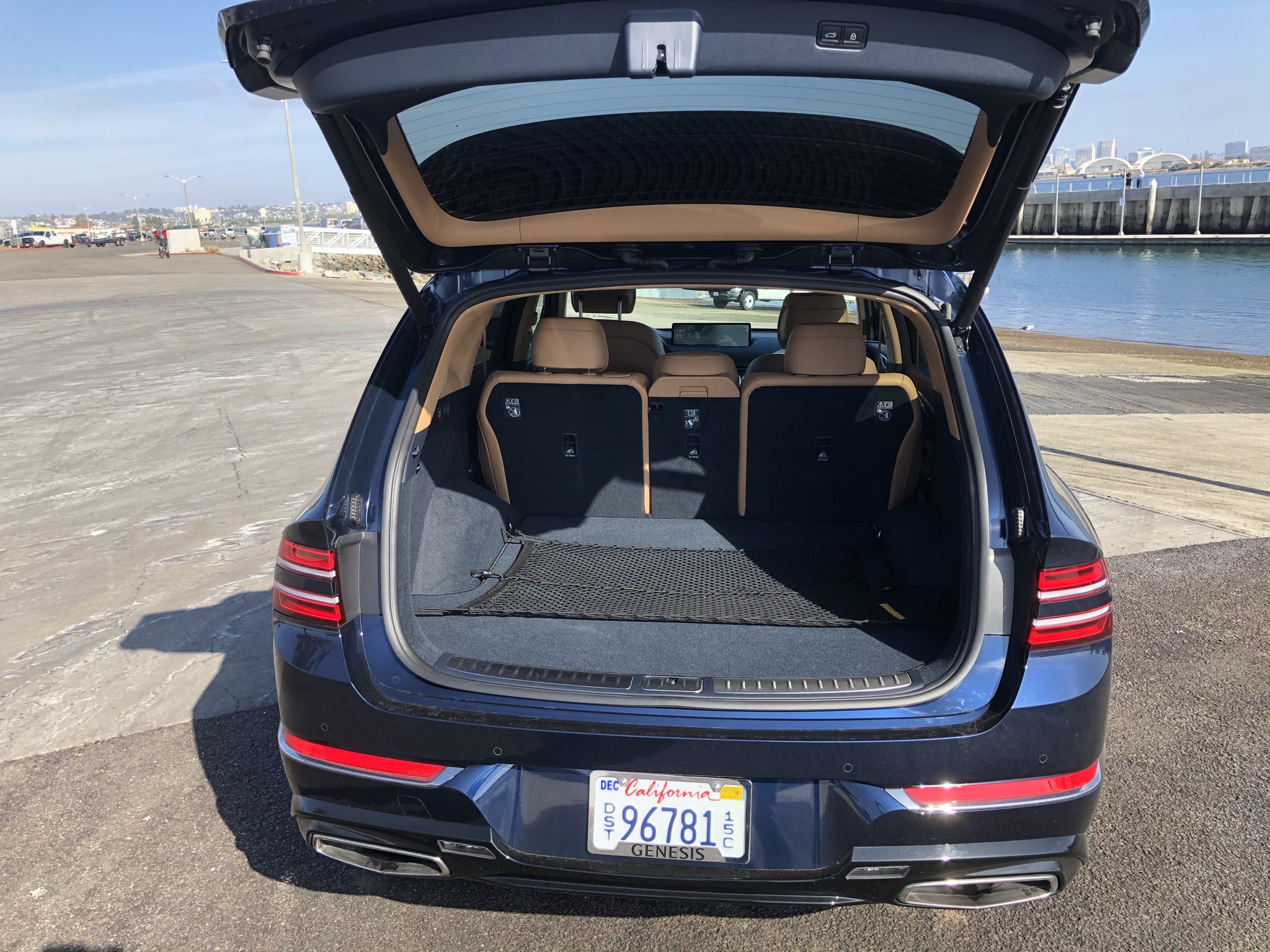
There is plenty of cargo room for the long road trip. Fold the second-row seatback for about 6 ½ feet of board room. (Mark Maynard)
GV80 Cargo
There is plenty of cargo room for the long road trip. Fold a section of the 40/20/40 seatbacks for about 6 ½ feet of board space. The opening is wide at 45 inches by 43 inches with the back seat in position and 30 inches to the headliner. The roller covers stows neatly in its own compartment under the cargo floor.
Ride and Handling
The steering weight is light and steady, but controlled at high speed. You might be surprised at how this SUV pulls through a big cornering maneuver with a flat and calculated effort, with no complaining from the big Michelins. The turning circle of 39.3 feet is wide but not unwieldy when tooling the shopping mall parking wars.
At 2 ½ tons, it is comfortable with its weight. The electronically controlled suspension automatically adjusts to trim body movement and harsh hits to the tires and wheel. A new feature called Road Preview, and standard on the GV80 3.5T, uses the front-facing camera to sniff the road ahead to prepare in advance of speed bumps and potholes.
The ride quality can be lush but never wallowy, and helped by the broad contact patch of the 22-inch Michelin Primacy (265/40) all-season touring tires. Head-toss is low over chunks and bumps, but because of the ride height and heft, it is not as svelte as a large luxury sedan, such as the G80.
2 New Engines
Both gasoline engines feature a dual fuel injection system that combines direction injection and multi-port injection. Combining both improves fuel efficiency, performance and reduced exhaust emissions, Genesis says.
Fuel economy, using the recommended premium fuel, for the 2.0-liter engine is 21 mpg city, 25 highway and 23 mpg for rear-drive and 21/25/22 mpg for AWD.
The 3.5T AWD has ratings of 18/23/20. I averaged 19.5 mpg in combined city and highway driving, and the onboard computer indicated a long-term 18.8 mpg overall average. With the 21.5-gallon tank, there should be a cruising range of around 380 miles.
The mileage ratings are competitive with comparable versions of the Audi Q7, BMW X5 and Mercedes-Benz GLE. But the Bimmer and Benz squeeze out two to three more mpgs per category, and they have slightly larger fuel tanks.
Driver-Assist Technologies
The Genesis GV80 is fluent in machine learning technology and is a conduit for advanced systems you did not know were necessary.
The bank of advanced driver-assistance systems includes:
- Highway Driving Assist II: This second-gen system now gives assist during lane change maneuvers — when the turn signal is used — and when other vehicles merge in front of you.
- Smart Cruise Control with Machine Learning: A world first, Genesis says, that helps the car learn the driving characteristics of — and assist — its driver.
- Forward Collision-Avoidance Assist: This system is intended to automatically stop the vehicle in certain situations where there is a risk of collision with an approaching vehicle detected on the left or right side of the intersection. The system may also help detect potential collision risks in certain situations where a pedestrian is sensed in close proximity to the vehicle while in motion, for example.
- Lane Side: LS helps prevent side collisions when merging into another lane with the ability to see two lanes over.
- Blind-Spot Collision-Avoidance Assist: BCA is essentially a Blind Spot Monitor that can alert the driver if a vehicle is detected in the driver’s blind-spot
- Lane Follow Assist: LFA helps maintain vehicle position in the center of its lane by recognizing both lane markers and vehicles traveling ahead.
- Lane-Change Oncoming: The so-called LO helps prevent collisions with vehicles in opposing lanes on non-divided highways or roads.
- Junction Turning: JT automatically applies the brakes if an oncoming vehicle is detected in the opposite lane when making a left turn at an intersection.
- Junction Crossing: JC automatically applies the brakes if a vehicle crossing from the left or the right is detected when entering an intersection.
- Evasive Steering Torque Assist: ESA assists in avoidance maneuvers by applying steering torque once the driver has initiated steering input.
- Rear Cross-Traffic Collision Avoidance-Assist: RCCA warns of vehicles coming from the left or right while backing up and automatically engages braking if a collision seems imminent.
Accolades
Genesis was ranked the No. 1 premium brand in the industry for the fourth consecutive year by J.D. Power’s 2020 Initial Quality Study and No. 1 overall in the J.D. Power 2020 Vehicle Dependability Study.
Consumer Reports ranked it the No. 2 brand in its annual 2020 Report Card.
And, the Insurance Institute for Highway Safety awarded all three 2020 Genesis vehicles — G70, G80 and G90 — with their highest rating of Top Safety Pick+. With those rankings, the company claims it is the only brand in the industry with an entire lineup that is rated a Top Safety Pick+.
Building the Brand
The genesis of Genesis goes back to the Hyundai Equus, the large, V8-powered sedan intended for the ultraluxury segment, competing with such established stars as the BMW 7-series, Lexus LS and Mercedes-Benz -Class. The U.S. model was heralded in 2009 at the Pebble Beach Concours d’Elegance, and was unveiled in 2010 at the New York Auto Show.
While stylistically and technologically competitive with the competing marques, the Equus was a dark horse in the race, and not widely accepted by the mainstream U.S. motorist. The well-turned-out product was bumping against a glass ceiling of perception: that Hyundai was a value brand, without the cache of prestige.
Some reviewers considered the Equus to be cut-rate luxury and were more comfortable with the familiar and accepted stars, as if this new model could never reach its zenith.
Seasoned Industry Professionals
But Hyundai’s leaders in Korea and the U.S. were betting otherwise and would establish an independent and elevated standalone brand. And a dream team of seasoned industry professionals were hired:
Luc Donckerwolke, former design director of Volkswagen Group’s Bentley, Lamborghini and Audi, is chief creative officer.
Mark del Rosso, former president of Audi of America, is CEO of Genesis North America.
Sang-Yup Lee, former designer of the Bentley Continental GT and C-6 Chevrolet Corvette, is head of design.
Filippo Perini, former Lamborghini head of design, is chief designer.
Peter Schreyer, formerly at Volkswagen and principal designer of the VW Golf, New Beetle and the Audi TT, is a president and heads design management.
Albert Biermann, former head of the BMW M performance division, oversees tuning and performance as executive vice president of performance development and high-performance vehicles.
Fayez Rahman, former development leader at BMW, is vice-president of architecture development.
Andrea Jensen, former designer at Škoda and Volkswagen, heads color and trim.
U.S company headquarters are in Fountain Valley, Calif., in the sprawling O.C. (Orange County). Vehicles are designed in Rüsselsheim, Germany; Namyang, South Korea, and Irvine, Calif. The vehicles are built in Ulsan, South Korea.

The GV80 SUV joins the lineup of G70, G80 and G90 sedans, with the slightly smaller GV70 SUV to follow later this year. (Genesis)
Why Buy the Genesis GV80?
Luxury should not be an IQ test to learn AI — Artificial Intelligence. Some of the other highly electronic luxury SUVs are intimidating to learn. Genesis smooths those learning curves with a glossy coat of empowering polish.
All of the GV80’s sophisticated displays, assist features and drivability work to lift the driver into an elevated ownership experience.
2021 Genesis GV80 AWD 3.5T Prestige
Body style: large, 5-seat, 5-door SUV
Engine: 375-hp, turbocharged and direct-injected 3.5-liter V-6 with idle stop-start; 391 lb.-ft. torque from 1,300-4,500 rpm
Transmission: 8-speed automatic with paddle shifters
Fuel economy: 18/23/20 mpg city/hwy/combined; premium fuel recommended
BY THE NUMBERS
Fuel tank: 21.1 gallons
Cargo space: 34.9-84 cu. ft. (11.6 cu. ft. behind 3rd row)
Front head/leg room: 40.2/41.6 in.
Rear head/leg room: 38.4/38.7 in. (3rd row: 34.3/30.3 in.)
Length/wheelbase: 194.7/116.3 in.
Width/height: 77.8/67.5 in.
Curb weight: 5,038 lbs.
Turning circle: 39.3 ft.
Max. towing: 6,000 lbs.
FEATURES
Standard equipment includes: Smart key locking and push-button ignition, Nappa leather, 21-speaker Lexicon Quantum Logic surround-sound audio system with satellite radio, 16-way power driver’s seat with adjustable side bolsters and cushion extension and 4-way power lumbar, massaging driver’s seat, 12-way power front passenger’s seat with 4-way power-adjustable lumbar support, heated and ventilated front seats, electric parking brake with auto hold, electronically controlled suspension with road preview, 22-inch 265/40 Michelin Primacy all-season touring tires and alloy wheels, tire mobility kit (in place of a temporary spare tire), carpeted floor mats, power back seat sunshades
Safety features include: 10 air bags, hill-start assist, stability and traction controls, blind-spot collision-avoidance assist with rear cross-traffic collision-avoidance assist, blind-spot view monitor, lane departure warning with lane keeping assist and lane following assist, forward collision-avoidance assist with pedestrian detection, lane-change oncoming, junction turning, junction crossing, lane-change side and evasive steering torque assist, parking collision-avoidance assist rear, forward attention warning
PRICING
Base price: $60,175, including $1,025 freight charge; price as tested $72,375
Options on test vehicle: Advance package, $5,200, includes full-leather upholstery, surround-view monitor and blind-spot view monitor, remote smart-parking assist, parking collision avoidance assist (rear), 21-speaker Lexicon audio system, head-up windshield display, power driver seat bolster and cushion extension, Ergo Motion (massaging) driver seat and heated second-row window seats
Prestige package, $6,600, added 22-inch alloy wheels with Michelin Primacy all-season tires, electronic limited slip differential, Nappa leather seating surfaces, microfiber suede headliner and roof pillars, 12.3-inch digital cluster, Road Active Noise Cancellation, power second-row seat recline-slide-cushion tilt, forward attention warning, power rear side window shades, ventilated second-row window seats, second-row vanity mirrors and power door closers.
Where assembled: Ulsan, Korea

